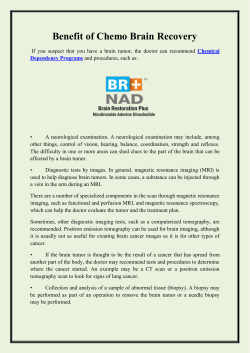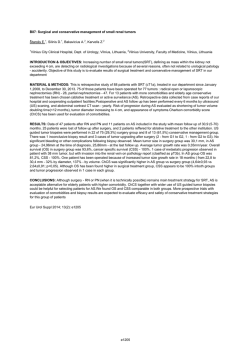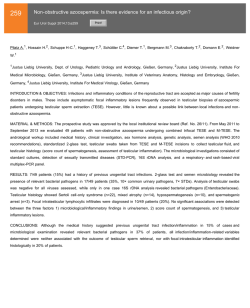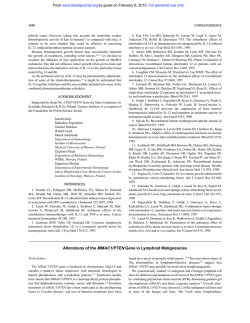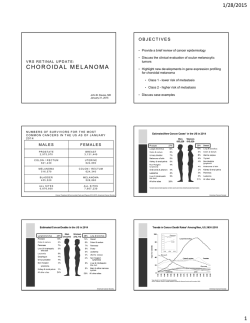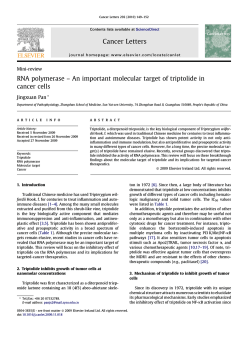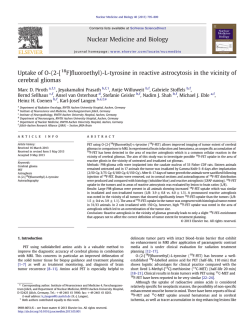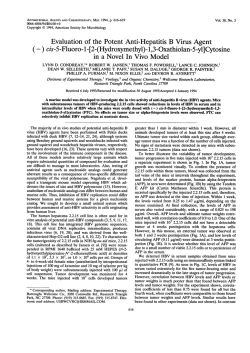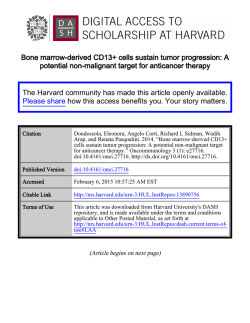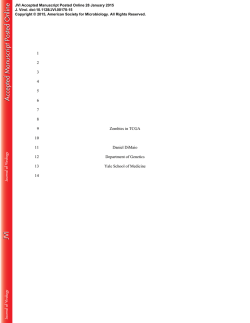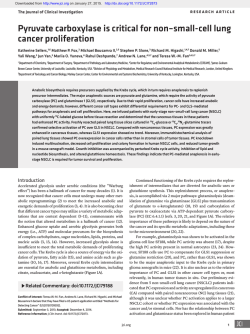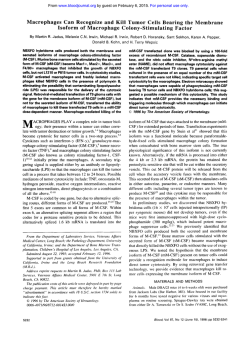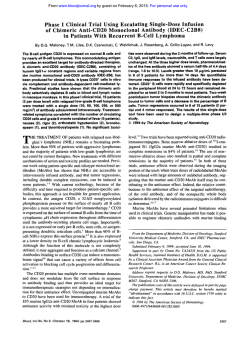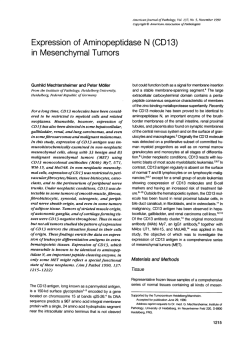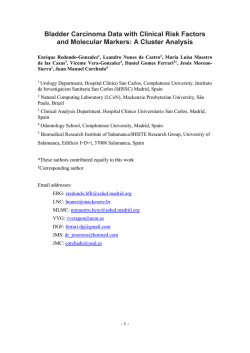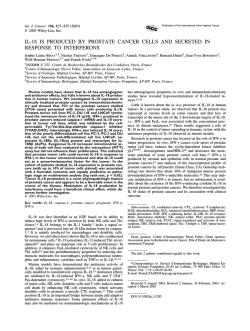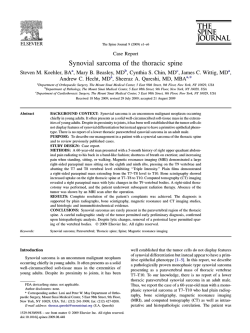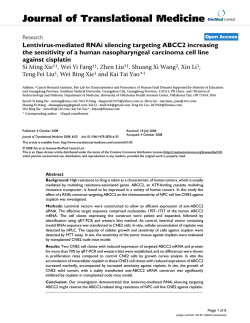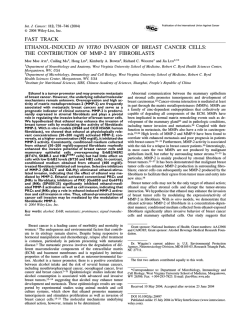
Surgical management of a giant retroperitoneal teratoma - revista
Rev Mex Urol 2014;74(4):234-237 ÓRGANO OFICIAL DE DIFUSIÓN DE LA SOCIEDAD MEXICANA DE UROLOGÍA, COLEGIO DE PROFESIONISTAS, A.C. www.elsevier.es/uromx Clinical case Surgical management of a giant retroperitoneal teratoma F. R. Zamora-Varelaa,*, A. Castro-Alfarob, J. C. Navarro-Vargasb, A. Scavuzzob, Z. A. Santana-Ríosb, P. F. Martínez-Cerverab and M. A. Jiménez-Ríosb a Urology Speciality Residency, Hospital Regional “Dr. Valentín Gómez Farías”, ISSSTE, Guadalajara, Jal., Mexico b Urology Division, Instituto Nacional de Cancerología, Mexico City, Mexico KEYWORDS Testis; Nonseminomatous; Giant teratoma; Mexico Abstract Testicular cancer is the most common cancer in men between the ages of 20 and 35 Palabras clave Testículo; No seminoma; Teratoma gigante; México. Manejo quirúrgico de un teratoma retroperitoneal gigante years. Teratomatous elements are found in 50% to almost 80% of nonseminomatous germ cell tumors (NSGCTs) and there are few reports in the literature on the resection of large-scale teratomas. A 28-year-old man had a past history of orchiectomy, which revealed a tumor with an 80% teratomatous composition, and he did not receive adjuvant treatment; 6 months later he presented with gastrointestinal symptomatology, weight loss, and lumbar pain, as well as a palpable abdominal mass. Alpha-fetoprotein (AFP) and β-subunit human chorionic gonadotropin (β-hCG) hormone levels were elevated. Plain chest x-ray showed metastatic lesions. Abdominal computed tomography (CT) scan identified a giant retroperitoneal tumor extending from the renal vessels to the left iliac vessels. The patient was given chemotherapy and his tumor marker (TM) values descended to normal. A control post-chemotherapy CT scan showed tumor progression and so the giant retroperitoneal tumor was resected. The iliac artery was infiltrated, and in turn, no dissection plane was observed. Therefore, en bloc resection was carried out at the level of the iliac vessels; a Dacron® graft was placed on the iliac artery with no complications. Flow was verified through intraoperative Doppler ultrasonography (US). The patient was released in good general condition. Advanced stage teratomas have a high recurrence rate after chemotherapy and therefore resection is recommendable due to the compression of neighboring structures. Giant retroperitoneal tumor resection has a mortality rate of up to 6%. Residual tumor resection was offered to our patient, given his symptomatology and in an effort to provide him with a better quality of life. Resumen El cáncer testicular es el cáncer más común en edades de 20 a 35 años, el teratoma abarca desde un 50% hasta casi el 80% de los tumores de células germinales no seminomatosos (TCGNS); la resección de TCGNS de gran dimensión está bajamente reportada en la literatura médica. * Corresponding author at: Paseo de las Brisas N° 4128-302, Colonia Lomas Altas, C.P. 45120, Zapopan, Jal., México. Telephone: 01 (33) 3749 3944. Email: [email protected] (F. R. Zamora-Varela). Surgical management of a giant retroperitoneal teratoma 235 Se presenta caso de masculino de 28 años de edad, con antecedente de orquiectomía de estirpe teratoma 80%, sin recibir tratamiento adyuvante; 6 meses después inicia con sintomatología gastrointestinal, pérdida de peso y dolor lumbar, así como masa abdominal palpable; con la alfa-fetoproteína (AFP) y la hormona gonadotrofina coriónica fracción-β (hCG-β) elevadas. La radiografía simple de tórax mostró lesiones metastásicas. La tomografía computarizada (TC) de abdomen evidencia tumor retroperitoneal gigante, desde los vasos renales hasta vasos ilíacos izquierdos. Recibió quimioterapia logrando descender los marcadores tumorales (MT) hasta valores normales. En la TC de control posquimioterapia se observa progresión tumoral, por lo que se realiza resección del tumor retroperitoneal gigante. Durante el procedimiento, a nivel de los vasos ilíacos se resecó en bloque debido a no tener plano de disección por infiltración a la arteria ilíaca, allí se colocó un injerto de Dacrón®, sin complicaciones. Se verificó su flujo con ultrasonido (US) Doppler transquirúrgico. El paciente se dio de alta en buenas condiciones generales. Los teratomas en etapas avanzadas tienen alta tasa de recaída después de la quimioterapia, por lo que es recomendable la resección debido a la compresión de estructuras vecinas. La resección de tumores retroperitoneales gigantes tiene una mortalidad de hasta el 6%. Debido a la sintomatología del paciente y con el fin de ofrecerle una mejor calidad de vida, se optó por brindarle la posibilidad de la resección del tumor residual. 0185-4542 © 2014. Revista Mexicana de Urología. Publicado por Elsevier México. Todos los derechos reservados. Introduction Testicular cancer is the most common cancer in men between the ages of 20 and 35 years. It makes up 1% of all neoplasias in men. Teratoma elements are found in 55% to 79% of the nonseminomatous germ cell tumors (NSGCTs) and metastasis has been reported in 27% to 46%. Approximately 30% to 40% of men with NSGCTs have signs of metastatic disease at tumor presentation onset. The curative rate for advanced disease varies between 80% and 90% with a multidisciplinary approach that includes platin-based chemotherapy followed by retroperitoneal lymph node dissection (RPLND) of the residual disease.1-3 Elevated tumor markers (TMs) despite primary chemotherapy are indicative of cancer persistence. RPLND is one of the standard managements of patients with NSGCTs at all stages. It is used as first-line treatment in patients with non-metastatic disease as an alternative to primary chemotherapy or surveillance and is used as first or second-line therapy in patients with regional retroperitoneal lymph node metastasis. And finally, RPLND is used for treating residual disease after chemotherapy in patients with metastatic NSGCT.2,4 the left iliac vessels (fig. 1). He received 4 cycles of chemotherapy with bleomycin, etoposide, and cisplatin (BEP) and the TMs descended to normal values. The postchemotherapy control CT scan revealed tumor progression (fig. 2) and so the decision was made to resect the giant retroperitoneal tumor that measured approximately 30 x 22 x 6 cm and weighed 1,500 g. The tumor surrounded the aorta, the vena cava, the superior and inferior mesenteric artery and the left common iliac vessels (fig. 3). En bloc resection was necessary because the tumor was found to be invading the iliac artery and, as a result, no dissection plane was observed. A Dacron® graft was placed on the artery with no complications (fig. 4) and flow was verified through an intraoperative Doppler ultrasound (US). Case presentation A 28-year-old man had a past history of orchiectomy that revealed a tumor with an 80% teratomatous composition, and he did not receive chemotherapy. Six months later he presented with gastrointestinal symptomatology, weight loss of 5 Kg in 2 months, and lumbar pain. Abdominal examination revealed a fixed, painful, palpable mass. TMs were: lactate dehydrogenase (LDH) 216, alpha-fetoprotein (AFP) 2,372, and β-subunit human chorionic gonadotropin (β-hCG) 395. A plain chest film showed lesions consistent with tumor activity that was then confirmed by computed tomography (CT), which also identified a giant retroperitoneal tumor extending from the renal vessels to Figure 1 Retroperitoneal tumor extending from the renal vessels; infiltration towards the left iliac vessels is observed. 236 Figure 2 Post-chemotherapy control tomography scan showing giant tumor progression after 4 cycles of bleomycin, etoposide, and cisplatin (BEP). F. R. Zamora-Varela et al Figure 3 Retroperitoneal resection of the giant tumor; aorta and vena cava are observed. En bloc tumor resection. There was a 5L blood loss and the total surgery duration was 7.30 hours. The patient had no postoperative complications and was released from the hospital in good general condition. He presented with diuresis of 0.7 mL/ Kg/h, warm extremities, adequate coloring, and distal pulses. Discussion The advent of chemotherapy considerably changed testicular tumor treatment and today it has high curative percentages. However, the presence of teratoma in the primary tumor has been a predictor for incomplete response to chemotherapy in cases of advanced disease. 2 Studies report that patients with NSGCTs in stages II and III with teratoma in the primary tumor, compared with patients without teratoma, have little radiologic response (defined as a residual mass of 15 mm or less) when treated with cisplatin.5,6 Advanced disease management is more difficult due to the aggressiveness of the chemotherapy. The appearance of residual disease obliges us to be more careful in relation to treatment because retroperitoneal resection of large masses is a complex procedure that is not exempt from complications, with a surgical mortality rate of 6% in advanced disease.2 Notwithstanding the fact that lymph node dissection continues to be standard treatment in NSGCTs, it is indicated in cases of failed chemotherapy when there is a giant teratomatous residual mass compressing neighboring structures.7,8 Furthermore, a high proportion of patients already presenting with advanced disease have shown a considerable risk for recurrence, despite complete resection of the residual mass.5 Conclusions The resection of giant retroperitoneal tumors has a mortality rate of up to 6%. Residual tumor resection was Figure 4 Dacrón® arterial graft placement. offered to our patient given his symptomatology and in an effort to provide him with a better quality of life. These giant retroperitoneal tumors should be treated in specialized centers and by highly experienced surgeons, given the formidable complexity of the procedure. Conflict of interest The authors declare that there is no conflict of interest. Financial disclosure No financial support was received in relation to this article. Surgical management of a giant retroperitoneal teratoma References 1. Masterson TA, Shayegan B. Clinical Impact of Residual Extraperitoneal Masses in Patients with Advanced Nonseminomatous Germ Cell Testicular Cancer. Urology 2012;79(1):156-159. 2. Capitanio U, Jeldres C, Perrotte P, et al. Population-based study of perioperative mortality after retroperitoneal lymphadenectomy for nonseminomatous testicular germ cell tumors. Urology 2009;74(2):373-377. 3. Carver BS, Cronin AM. The total number of retroperitoneal lymph nodes resected impacts clinical outcome after chemotherapy for metastatic testicular cancer. Urology 2010;75(6):1431-1335. 237 4. Coogan CL, Foster RS. Postchemotherapy retroperitoneal lymph node dissection is effective therapy in selected patients with elevated tumor markers after primary chemotherapy alone. Urology 1997;50(6):957-962. 5. Rabbani F, Farivar-Mohseni H. Clinical outcome after retroperitoneal lymphadenectomy of patients with pure testicular teratoma. Urology 2003;62(6):1092-1096. 6. Karam JA, Raj GV. Growing Teratoma Syndrome. Urology 2009;74(4):783-784. 7. Ozen H, Ekici S. Resection of Residual Masses alone: An alternative in surgical therapy of metastatic testicular germ cell tumors after chemotherapy. Urology 2001;57 (2):323-327. 8. Giménez Bachs JM, Salinas Sánchez AS. Cirugía de gran masa residual tras quimioterapia en tumor germinal testicular avanzado. Actas Urol Esp 2004;28(3):230-233.
© Copyright 2025
